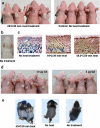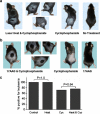Prevention of chemotherapy-induced alopecia in rodent models
- PMID: 18347939
- PMCID: PMC2666212
- DOI: 10.1007/s12192-007-0005-1
Prevention of chemotherapy-induced alopecia in rodent models
Abstract
Alopecia (hair loss) is experienced by thousands of cancer patients every year. Substantial-to-severe alopecia is induced by anthracyclines (e.g., adriamycin), taxanes (e.g., taxol), alkylating compounds (e.g., cyclophosphamide), and the topisomerase inhibitor etoposide, agents that are widely used in the treatment of leukemias and breast, lung, ovarian, and bladder cancers. Currently, no treatment appears to be generally effective in reliably preventing this secondary effect of chemotherapy. We observed in experiments using different rodent models that localized administration of heat or subcutaneous/intradermal injection of geldanamycin or 17-(allylamino)-17-demethoxygeldanamycin induced a stress protein response in hair follicles and effectively prevented alopecia from adriamycin, cyclophosphamide, taxol, and etoposide. Model tumor therapy experiments support the presumption that such localized hair-saving treatment does not negatively affect chemotherapy efficacy.
Figures


References
-
- {'text': '', 'ref_index': 1, 'ids': [{'type': 'PMC', 'value': 'PMC109079', 'is_inner': False, 'url': 'https://pmc.ncbi.nlm.nih.gov/articles/PMC109079/'}, {'type': 'PubMed', 'value': '9710578', 'is_inner': True, 'url': 'https://pubmed.ncbi.nlm.nih.gov/9710578/'}]}
- Ali A, Bharadwaj S, O’Carroll R, Ovsenek N (1998) HSP90 interacts with and regulates the activity of heat shock factor 1 in Xenopus oocytes. Mol Cell Biol 18:4949–4960 - PMC - PubMed
-
- {'text': '', 'ref_index': 1, 'ids': [{'type': 'DOI', 'value': '10.1159/000048253', 'is_inner': False, 'url': 'https://doi.org/10.1159/000048253'}, {'type': 'PubMed', 'value': '11914593', 'is_inner': True, 'url': 'https://pubmed.ncbi.nlm.nih.gov/11914593/'}]}
- Christodoulou C, Klouvas G, Efstathiou E, Zervakis D, Papazachariou E, Plyta M, Skarlos DV (2002) Effectiveness of the MSC cold cap system in the prevention of chemotherapy-induced alopecia. Oncology 62:97–102 - PubMed
-
- {'text': '', 'ref_index': 1, 'ids': [{'type': 'PubMed', 'value': '9783595', 'is_inner': True, 'url': 'https://pubmed.ncbi.nlm.nih.gov/9783595/'}]}
- Dorr VJ (1998) A practitioner’s guide to cancer-related alopecia. Semin Oncol 25:562–570 - PubMed
-
- {'text': '', 'ref_index': 1, 'ids': [{'type': 'PubMed', 'value': '10544189', 'is_inner': True, 'url': 'https://pubmed.ncbi.nlm.nih.gov/10544189/'}]}
- Garrido C, Bruey JM, Fromentin A, Hammann A, Arrigo AP, Solary E (1999) HSP27 inhibits cytochrome c-dependent activation of procaspase-9. FASEB J 13:2061–2070 - PubMed
-
- {'text': '', 'ref_index': 1, 'ids': [{'type': 'DOI', 'value': '10.1002/1097-0045(20000915)45:1<58::AID-PROS7>3.0.CO;2-#', 'is_inner': False, 'url': 'https://doi.org/10.1002/1097-0045(20000915)45:1<58::aid-pros7>3.0.co;2-#'}, {'type': 'PubMed', 'value': '10960843', 'is_inner': True, 'url': 'https://pubmed.ncbi.nlm.nih.gov/10960843/'}]}
- Gibbons NB, Watson RWG, Coffey RNT, Brady HP, Fitzpatrick JM (2000) Heat-shock proteins inhibit induction of prostate cancer cell apoptosis. Prostate 45:58–65 - PubMed
Publication types
MeSH terms
Substances
Grants and funding
LinkOut - more resources
Full Text Sources
Other Literature Sources

